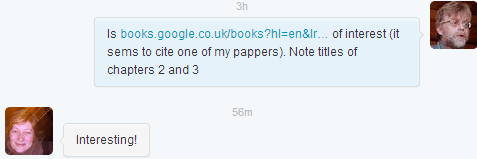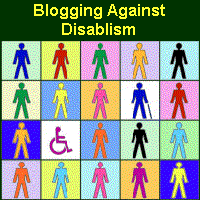Institutional Web Accessibility Policies
 What type of policies do institutions provide on the accessibility of corporate web sites? This question is very relevant to the workshop session on “BS 8878: Systematic Approaches to Documenting Web Accessibility Policies and Practices” which I am running at the IWMW 2015 event; considerations of the relevance of use of the BS 8878 code of practice for web accessibility should be informed by an understanding
What type of policies do institutions provide on the accessibility of corporate web sites? This question is very relevant to the workshop session on “BS 8878: Systematic Approaches to Documenting Web Accessibility Policies and Practices” which I am running at the IWMW 2015 event; considerations of the relevance of use of the BS 8878 code of practice for web accessibility should be informed by an understanding
Analysing a Small Sample of Web Accessibility Policies
Rather than looking at a large selection of web accessibility policies I chose to select a small sample. And rather than looking at Russell Group universities, as I have done in the past when analysing institutional approaches across a range of different areas, this time I looked at nine universities based in the north west, near Edge Hill University, the host for the IWMW 2015 event.
All ten institutions helpfully provided links to their web accessibility policies from their home page (and, I suspect, in the navigational areas for other corporate pages). The accessibility policies can be view using the following links:
[Edge Hill] – [Liverpool John Moores] – [Liverpool] – [Liverpool Hope] – [UCLAN] – [Bolton] – [Manchester] – [MMU] – [Salford]
Looking at the web accessibility policies a number of characteristics can be identified:
Aspirations: Such as “The University is committed to making its website and the material provided on it accessible to as many people as possible“; “The site aims to be compliant with worldwide standards for accessibility“; “The University website is designed to be as accessible as possible to all, in line with W3C recommendations“;
Aspirational to conform with WCAG: Such as “All pages on this site aim to be accessible to W3C AA compliance or better, complying with priority 1 and 2 guidelines of the W3C Web Content Accessibility Guidelines. Not all the guidelines can be automatically checked. With this in mind every effort has been made to manually check university pages.“
Specific WCAG conformance levels: Such as “This central site is intended to meet at least level 2 (AA) of the W3C’s Website Accessibility Initiative (WAI) Guidelines, and as far as possible to meet level 3 (AAA).“
Browser policies: Such as “We try to make our website compatible with as many browsers as possible“
Details of testing processes: Such as “We have also tested the site extensively in a wide range of browsers and settings to ensure the site functionality is available to as many users as possible“;
Techniques for users: Such as “You can increase or reduce the text size by using your browser’s zoom function“
Specific techniques for users: Such as “Microsoft Internet Explorer version 8 and above …; Mozilla Firefox: To alter text size, select ‘zoom’ select zoom in (Ctrl+) or zoom out (Ctrl-). To remove CSS stylings select ‘page style’, then no style”; Safari: Select ‘view’ from the top pull down menu options; To alter text size, select ‘zoom’ select zoom in (Ctrl+) or zoom out (Ctrl-); Google Chrome: Select ‘settings’ from the top pull down menu options. Click ‘show advanced settings’ and scroll to fonts size and page zoom; To alter text size, select view, then ‘zoom’ select larger (Ctrl+) or smaller (Ctrl-)“
Details of access keys: Such as “Access keys for websites are defined as: Access Key 1 – Homepage; Access Key 2 – News; Access Key 4 – Focus on Search box; Access Key 9 – Feedback Form; Access Key 0 – Accessibility Help generic medication (this page)“
Techniques used by content providers: Such as “Steps we’ve taken: Using alt tags on images; Using sufficient contrast on colours; Using CSS to allow the separation of style and content; ..“; “Use of ‘alternative text’ to describe images. This is useful for text-based browsers and/or for users with visual impairments; Implementation of ‘skip menu’ feature to allow users of speech or text rendering software to bypass the menu structure of a page and go straight to the content; Links to the Adobe Acrobat reader for PDF Adobe Acrobat files; Use of ‘cascading style sheets’ (CSS) which means that it is easy for a user to over-ride page settings to make it easier for them to view the page. In this way you can; Increase contrast between background and text for readability purposes; Change text colours; Change background colours; Ensuring that fields in online forms can be navigated in order by pressing ‘tab’ in a keyboard“
Details of training and support: Such as “staff are offered a comprehensive training programme “
Contact details for further information or in case or problems: email address; links to disability support services.
Note that all of these examples are taken from public accessibility policies available from the following pages: [Edge Hill] – [Liverpool John Moores] – [Liverpool] – [Liverpool Hope] – [Edge Hill] – [UCLAN] – [Bolton] – [Manchester] – [MMU] – [Salford].
Reflections
It should be noted that accessibility policies typically go beyond statements of conformance with WCAG guidelines and may include specific techniques for users, details of the processes used to create web resources, details of testing processes used to ensure policies are being implemented correctly and contact details in case of accessibility problems. However these approaches are not taken in a consistent manner. Also none of the pages appeared to describe maintenance of the information provided, such as accessibility tips for new browsers or new versions of browsers. It was also noted that there appeared to be no information provided for users of mobile devices which perhaps suggests that the information has not been updated for some time.
Time for BS 8878?
The BS 8878 code of practice for web accessibility seeks to formalise the process for ensuring the accessibility of web resources by documenting 16 steps which can help to ensure the production of an accessible web ‘product’ (to use the terminology of BS 8878). The 16 steps cover research & understanding in the initial conception and requirements analysis for the web product; making strategic choices based on that research; the decision whether to create or procure the web product in-house or contract out externally; the production of the web product; the evaluation of the product and the launch of the web product.
A workshop session on “BS 8878: Systematic Approaches to Documenting Web Accessibility Policies and Practices” at the IWMW 2015 event will explore how BS 8878 can be used in an educational context, going beyond provision of public web sites and including use of the web in teaching and learning and research applications.
If you have an interest in BS8878 you may wish to book a place at the IWMW 2015 event. The event will take place on 27-29 July at Edge Hill University. Bookings are still open, but will close shortly.
In addition if you have any comments, questions or observations on issues related to web accessibility and BS 8878 feel free to leave a comment.



















 A related approach to enhancing accessibility by focussing beyond the digital resource could be images of an event. The
A related approach to enhancing accessibility by focussing beyond the digital resource could be images of an event. The 




















You must be logged in to post a comment.